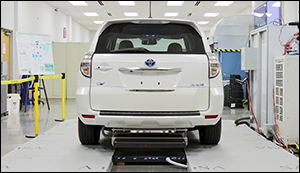ORNL surges forward with 20-kilowatt wireless charging for vehicles
1. 4. 2016 | Oak Ridge National Laboratory | www.ornl.gov
A 20-kilowatt wireless charging system demonstrated at Department of Energy’s Oak Ridge National Laboratory has achieved 90 percent efficiency and at three times the rate of the plug-in systems commonly used for electric vehicles today.
ORNL’s power electronics team achieved this world’s first 20-kilowatt wireless charging system for passenger cars by developing a unique architecture that included an ORNL-built inverter, isolation transformer, vehicle-side electronics and coupling technologies in less than three years. For the demonstration, researchers integrated the single-converter system into an electric Toyota RAV4 equipped with an additional 10-kilowatt hour battery.

The researchers are already looking ahead to their next target of 50-kilowatt wireless charging, which would match the power levels of commercially available plug-in quick chargers. Providing the same speed with the convenience of wireless charging could increase consumer acceptance of electric vehicles and is considered a key enabler for hands-free, autonomous vehicles. Higher power levels are also essential for powering larger vehicles such as trucks and buses.
Read more at Oak Ridge National Laboratory
Image Credit: Oak Ridge National Laboratory
-jk-




